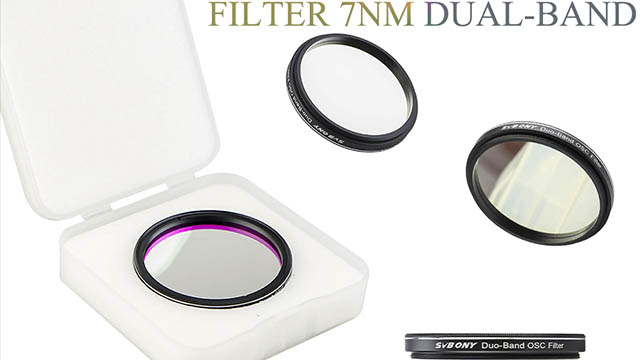About Dual-Band You Need to Know These ---SV220 Telescope Filter 7nm Nebula 1.25/2 Inches

About Dual-Band You Need to Know These ---SV220 Telescope Filter 7nm Nebula 1.25/2 Inches
Using dual narrowband filters in astrophotography offers several advantages.
Firstly, they allow for the effective reduction of light pollution and natural skyglow. By selectively filtering specific emission lines, such as H-alpha (Ha) and OIII, dual narrowband filters can block out unwanted artificial and atmospheric light sources, resulting in improved contrast and signal-to-noise ratio.
Secondly, dual narrowband filters provide enhanced isolation of the desired emission lines from astronomical targets. By isolating specific wavelengths associated with Ha and OIII, these filters effectively suppress background noise and improve the visibility of nebulae, planetary nebulae, and other emission objects. This enables astrophotographers to capture finer details and reveal the unique spectral characteristics of these celestial objects.
Lastly, using dual narrowband filters allows for precise imaging of specific features or phenomena in the universe. For example, Ha filters are particularly sensitive to regions of ionized hydrogen gas, which is prevalent in star-forming regions, while OIII filters can highlight regions of doubly ionized oxygen, revealing structures like supernova remnants or planetary nebulae. By combining the data obtained through these filters, astrophotographers can create stunning images that showcase different aspects of celestial objects.
Why dual narrowband filters tend to be more expensive?
Narrowband filter technology: It requires high-precision optical technology and materials to efficiently and selectively filter specific wavelength ranges.
High-quality standards: Dual narrowband filters need to meet stringent optical performance and stability requirements to ensure consistent and reliable image quality. Manufacturers must implement rigorous quality control and testing procedures to ensure that each filter delivers optimal imaging results. This drives up the manufacturing cost.
Specialized market demand: Compared to standard broad-spectrum filters, Manufacturers invest more resources in research, development, and production to meet the demands of this specialized market, which can result in higher prices.
It's worth noting that while dual narrowband filters may be more expensive, they play a crucial role in delivering high-quality astrophotography and research results. Investing in these filters can be worthwhile.
The SV220 2'' dual narrowband filter we previously launched has received love and support from many customers. Recently, we have also released a 1.25'' filter based on user needs. Have you started to experience it?
Welcome to give us feedback! If you have any questions, feel free to contact us.








